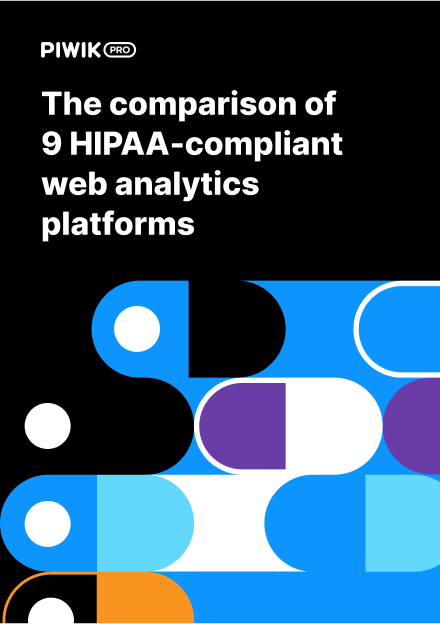Disclaimer: This blog post is not legal advice. Piwik PRO provides privacy-friendly analytics software, but doesn’t provide legal consultancy. If you’d like to make sure that you comply with HIPAA guidelines, we encourage you to consult an attorney.
Telehealth adoption grew exponentially during the COVID-19 pandemic, with usage rates increasing 38 times compared to pre-pandemic levels. Telehealth has revolutionized healthcare, with virtual consultations making up over 30% of US healthcare visits in 2024. Even as in-person visits return, telehealth remains a fixture in healthcare delivery and is projected to grow into a $455.27 billion market by 2030.
As patients increasingly turn to digital platforms for medical care, healthcare organizations must understand user behavior and tailor their responses to meet these expectations. Patients want flexible, digital-first options, while providers seek to optimize efficiency, reduce costs, and expand care to more people.
Without accurate analytics, organizations can struggle to understand how patients experience telehealth and its impact on business results. Additionally, handling telehealth data typically requires adhering to privacy regulations, such as HIPAA.
In this article, we will provide practical strategies for implementing HIPAA-compliant telehealth analytics to help healthcare providers, marketers, and digital managers optimize virtual care while prioritizing privacy.
Why telehealth analytics matters
The rise of telehealth has reshaped patient expectations, demanding seamless, secure, and personalized virtual care experiences. Analytics plays a critical role in understanding how patients interact with telehealth platforms, from scheduling appointments to engaging in virtual consultations.
However, the sensitive nature of telehealth data – often including names, emails, IP addresses, or medical details, and frequently matching the definition of protected health information (PHI) – requires appropriate protection. HIPAA non-compliance can result in fines exceeding $100,000 per violation, as well as legal repercussions and eroded patient trust.
Virtual care covers various touchpoints throughout the patient journey.
- Improve access to care
- Enhance the quality of digital experiences
- Reduce patient churn
- Increase revenue
- Improve patient satisfaction, loyalty and referrals
For example, by analyzing the data behind appointment reminders, time-of-day scheduling, and follow-up engagement, healthcare providers can reduce no-show rates, lowering care disruption. With insights into past patient behavior, such as medication and healthcare follow-ups, they can personalize reminders for chronic care, ultimately increasing adherence rates.
Common challenges of telehealth analytics under HIPAA and how to overcome them
| Challenge | Solution |
|---|---|
| Ensuring ePHI security and compliance with privacy regulations while handling the data | Use HIPAA-compliant platforms that match the following requirements: – Business Associate Agreement (BAA) – HIPAA-compliant hosting (ideally US-based) – 256-bit encryption at rest and in transit – Audit-ready infrastructure, including detailed PHI access logs |
| Balancing personalization with privacy | Implement consent-driven, secure data activation to create personalized experiences across channels. |
| Measuring telehealth ROI for engagement and acquisition | Use first-party data to track conversions and optimize campaign performance. |
| Simplifying integrations with telehealth platforms | Integrate analytics with telehealth tools via secure APIs and server-side tagging to prevent PHI leaks. |
| Collecting complete, accurate patient data | Incorporate anonymized metrics and segmentation in your data strategy. |
However, many standard tools fall short when it comes to compliance:
- Google Analytics does not offer BAAs. It stores collected data in non-HIPAA-compliant environments and uses it to improve its services.
- Meta Pixel and other adtech tools automatically send data containing PHI to third parties, creating legal and reputational risks for organizations that use them.

COMPARISON
Need help choosing a HIPAA-compliant platform for telehealth analytics?
Our vendor comparison guide cuts through the noise with side-by-side feature comparisons and vendor highlights. Choose between Piwik PRO, Freshpaint, Matomo, Mixpanel, Amplitude, Heap, Tealium, Adobe CJA and Piano Analytics.
Elements of HIPAA-compliant telehealth analytics
Analyzing patient data while maintaining HIPAA compliance presents significant challenges for analytics providers. With the right tools and methods in place, healthcare organizations can achieve effective and legally compliant marketing.
Data minimization and purpose limitation
Collecting excessive patient data increases your compliance burden, storage costs, and the potential impact of any security incident. Capture only the data necessary for a specific purpose rather than trying to gather as much data as possible.
- Avoid gathering unnecessary PHI, such as full names (unless required) and focus on metrics like page views, session times and appointment completion.
- Clearly document the purpose for collecting each piece of data and regularly audit your collection practices.
Secure data collection and storage
HIPAA mandates safeguards like 256-bit AES encryption for data at rest and in transit, alongside secure hosting environments. Telehealth analytics platforms must ensure that data is stored in HIPAA-compliant locations and protected by access controls, including role-based permissions for all individuals handling patient data.
- Implement server-side tagging to process data on secure servers, minimizing the amount of client-side scripts that could expose PHI.
- Regularly audit logs to detect unauthorized access attempts.
Consent management
Patient trust depends on transparency about how their data is being used, and HIPAA requires demonstrable consent for specific data processing activities. You need to implement consent pop-ups that clearly explain data usage and allow users to opt in or out.
- Maintain detailed records of patient consent for use in analytics.
- Ensure your consent tracking integrates seamlessly with your analytics workflows – for example, allowing you to quickly identify and exclude non-consenting patients from specific activations.
Data activation
Analytics platforms should go beyond reporting to enable personalized notifications or follow-up recommendations. Data activation allows you to turn analytical insights into action, and with the right vendor, you can maintain patient privacy throughout the process.
- Use segmented data to trigger automated appointment reminders sent via secure email platforms.
- Ensure that your activations comply with HIPAA’s requirements, including obtaining proper patient authorization for marketing or sales purposes.
Get inspiration for effectively activating data in healthcare: How can healthcare organizations benefit from using a customer data platform (CDP)
Integrations with other systems
Healthcare organizations rely on multiple platforms to deliver care, and siloed data prevents you from understanding the complete patient journey or measuring program effectiveness. This makes it crucial to connect other systems in a way that is both secure and uninterrupted.
- Establish secure API connections with electronic EHRs, CRMs, billing systems, support platforms and other healthcare systems using industry-standard security protocols and authentication mechanisms.
- Map data flows between all connected systems and ensure HIPAA compliance through proper Business Associate Agreements (BAAs) and technical safeguards.
Attribution and ROI measurement
Understanding the effectiveness of telehealth campaigns requires accurate attribution models that respect privacy. Traditional tools that rely on third-party cookies often conflict with HIPAA, necessitating the use of first-party data solutions.
- Employ first-party tracking to attribute conversions, such as appointment bookings, to specific campaigns, ensuring compliance while optimizing marketing budgets.
- Focus on population-level methods and operational metrics rather than gathering data on individual patients.
Best practices for HIPAA-compliant telehealth analytics
Map the whole patient journey
Use analytics to track key touchpoints, such as login, consultation or feedback forms, to identify friction points, like patients abandoning scheduling forms, and success milestones, like completed visits or repeat bookings. By optimizing the patient journey, you can enhance usability and improve the overall experience.
For example, high drop-off rates during telehealth onboarding may indicate a complex scheduling process. Simplifying navigation can boost patient retention.
Define the right KPIs
Key performance indicators (KPIs) for telehealth differ significantly from those for traditional care. Consider using the following:
- Appointment completion rate
- Patient wait time in virtual sessions
- Average consultation length
- Technical failure rate (for example, abandoned calls)
- Follow-up scheduling percentage
- Patient satisfaction (via post-visit surveys)
Implement anonymization
Enable anonymous tracking for non-PHI metrics, like page views or click rates, to enhance data accuracy while minimizing compliance risks. For example, track navigation patterns on a telehealth portal without logging identifiable patient details.
Balance personalization with privacy
- Appointment reminders
- Personalized health education content
- Chronic disease management prompts
Leverage real-time data
Use live dashboards to monitor patient interactions and dynamically adjust telehealth user experience. For instance, identifying long wait times in virtual waiting rooms enables real-time tweaks to scheduling algorithms, improving patient satisfaction.
Audit and monitor
Regularly review access logs and conduct HIPAA compliance audits to ensure alignment with existing regulations and prepare for upcoming ones. For example, organizations should familiarize themselves with the pending HIPAA Security Rule updates proposed in January 2025 and adjust their strategy as needed.
Recommended methods include implementing multi-factor authentication and conducting annual risk assessments, as well as regular vulnerability scans, to protect sensitive patient data. They should also enhance the safeguards they apply, such as encryption and server-side tagging.
Conclusion
Adopting secure, practical strategies can enhance patient outcomes and compliance. From secure data collection to patient-centric outcomes, HIPAA-compliant telehealth analytics unlock the potential of virtual care while prioritizing privacy.
- Understand patient behavior and satisfaction
- Reduce inefficiencies like missed appointments
- Improve health outcomes with better engagement
- Attribute marketing and outreach ROI
But the stakes are higher in healthcare: compliance with HIPAA and patient trust can’t be compromised. By following our best practices, providers can leverage virtual care as a competitive advantage.
Effective telehealth analytics with Piwik PRO
Piwik PRO offers a HIPAA-compliant, privacy-first platform that covers both measurement and activation. Piwik PRO Analytics Suite combines analytics, tag management, consent management, and data activation in a single platform, reducing complexity and compliance risk.
- Track telehealth experiences securely: From scheduling to follow-ups, with all PHI protected.
- Work with complete patient data: No need to de-identify, thanks to a signed BAA.
- Host data safely in the US: Using HIPAA-compliant Microsoft Azure data centers.
- Encrypt and control access: 256-bit AES encryption and granular role-based permissions.
- Activate insights in real-time: Reduce no-shows, deliver personalized reminders, and increase patient satisfaction.
Ready to implement HIPAA-compliant analytics for your telehealth program?
Talk to our team and see how your organization can balance privacy compliance with access to valuable insights:
FAQ about telehealth analytics
What telehealth data is considered PHI?
Any data that links health information to identifiers such as names, email addresses, IP addresses, or appointment details is considered PHI under HIPAA. Analytics systems must secure this data to avoid violations.
How can analytics integrate with telehealth platforms?
Secure APIs and server-side tagging enable integration with platforms like Zoom or Doxy.me, ensuring data flows remain HIPAA-compliant.
Why is HIPAA compliance critical for telehealth analytics?
Compliance protects patient trust, avoids high fines and enables the safe use of data for improved care delivery.
How can I measure telehealth ROI?
Use first-party data and attribution models to track conversions (like appointment bookings) and campaign performance, optimizing budgets while staying compliant.
What are the risks of non-compliant analytics in telehealth?
Non-compliant tools risk PHI exposure, leading to regulatory penalties, lawsuits, and reputational harm, undermining patient confidence in virtual care.










